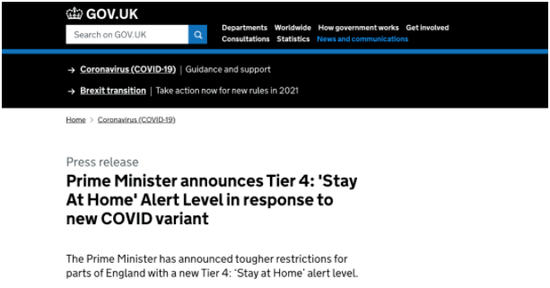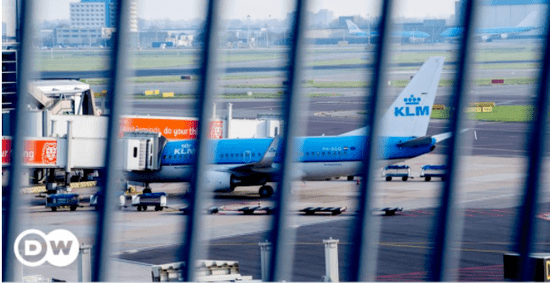“Escape from London”: Why the coronavirus mutant strain is “out of control” in the UK | Quick Review
In the past two days, the news that “the new strain of the novel coronavirus in the United Kingdom has lost control and implemented the strictest lockdown order” has attracted widespread attention from international public opinion.
On the Internet, a large number of London residents gathered to “escape from London” videos are popular.
Matthew Hancock, the British Health Secretary of State, also said on the 20th that the spread of the new strain of the novel coronavirus in the United Kingdom is “out of control” and can only be controlled by restricting social contact.
Everyone in England’s fourth-level epidemic prevention areas must comply with the regulations, “as if they will be infected with the novel coronavirus”. Hancock said that cases of infection with the new strain have also been found in Australia and continental Europe.
What does it mean to be “70% more transmittability”?
At present, the public is most concerned that the new variant of the novel coronavirus is believed to be 70% more transmittible than the original strain.
The short-term announcement of stricter restrictions in the United Kingdom, the panic among the local people, and the emergency restrictions on dealings with British personnel in many countries are all in response to the serious situation of the rapid spread of the epidemic after the emergence of the novel coronavirus mutation strain.
After all, “70% more transmittance” means that the new mutant strain only needs fewer viruses to achieve the same degree of infection. For Britain, which is about to celebrate Christmas, it is destined to put more pressure on it.
It is understood that the new strain, named VUI-202012/01, appeared in London or Kent in southeastern England in September this year. VUI-202012/01 saw mutations at 17 sites, the most important of which was the N501Y mutation of the spiny protein.
COVID-19 is an RNA virus. It is relatively normal for RNA virus to have lesions. At present, there are 4,000 mutations in spiny proteins. Most of them have no effect on the virus, and only a small number of mutations will affect the infectivity of the virus.
More than 60 percent of new coronavirus cases in London are currently linked to new strains, accounting for 59 percent of cases in the east and 48 percent of cases in the southeast, according to analysis by British researchers.
As of December 13, 1,108 cases caused by new strains have been found in nearly 60 different regions of the United Kingdom.
In the general public’s understanding, the emergence of virus mutation and faster transmission means that the virus is more dangerous.
But there is no evidence that new strains are more deadly or can cause more serious diseases, nor is there any evidence that the vaccine will be less effective against the new strain.
Previously, viral mutations had occurred all over the world, and they were only minor mutations.
According to the main points of epidemiology prevention and control, the epidemic can be completely prevented and controlled by detecting the source of infection, cutting off the infection route and protecting the vulnerable.
The bigger question now is whether the current test agents can detect new variants, and whether the antibodies produced in people cured by early virus infection can produce the same level of immunity to the new variants and avoid easy rejuvenation.
To prevent the new strain from “out of control”, the first thing to do is to prevent people from panic.
In view of the current emergency situation, the British and London authorities have made a decision to prevent and control the epidemic at four levels.
The previous epidemic prevention and control alert system in the United Kingdom was divided into three levels, corresponding to the three epidemic alert levels of “medium”, “high” and “very high” and the corresponding prevention and control measures.
The current fourth level is new and is designed to cope with the increase in the mutation and transmission rate of the virus.

The new restrictions require people to work from home, avoid overnight stays elsewhere, and do not leave the local area. People across England are also advised not to travel.
At the same time, Christmas activities in areas with level 4 restrictions will be cancelled, and people in level 3 restrictions must change their Christmas plans.
But this is still different from the “lockdown” – it also allows people to work and have limited one-on-one socialization outdoors. Moreover, the population of the fourth level of epidemic prevention in Britain is only 16.4 million, accounting for about one-third of the population of England, limited to London and southeastern England.
Tighten the string of epidemic prevention because of the urgency of the situation. It is thought-provoking that as soon as the news came out, Londoners not only did not stay at home, but also “escaped from London” in large numbers. Before fleeing London, London’s major shopping streets were crowded with the public.
There are many reasons why the public fled London due to the announcement that the epidemic prevention and control has escalated to the highest level four, but now it seems that biomedical factors and the epidemic itself account for a smaller proportion, while sociocultural factors are the majority.
The word “virus mutation” alone is enough to frighten many people. In the end, it was also the panic that caused the “escape” of the people in London.
For the British, Christmas is a sacred and happy traditional festival. In addition to bidding farewell to the old and welcoming the new, it is more important to get together with family and friends.
But due to the rampant epidemic and the escalation of measures to deal with the epidemic, people’s desire to celebrate Christmas in London and southeastern England will be frustrated. Disappointed, the first reaction of many Londoners was to flee.
However, it happened to “escape from London” and became the biggest variable of epidemic prevention and control in Britain.
With the public “flight”, London’s St Pancras train station and other stations and airports have gathered large crowds, making it completely impossible to maintain proper social distancing, instead creating better conditions for the virus to spread.
Because of the need to transfer to take public transportation, it also provides opportunities for the spread of the virus on a large scale.
Nowadays, some Britons also realize that it is very stupid and irresponsible to escape from London just for the holiday and to reunite with their families.
Compared with the possibility of infection and infection, staying at home is the best way to prevent and control the epidemic by complying with the decision of level four prevention and control.
This is also a reminder to the British authorities that in addition to the directives issued by the public health department and other government departments to upgrade the epidemic prevention and control, it is also necessary to spread more simple common sense of epidemic prevention and control.

At present, the WHO Regional Office for Europe said that in the face of the spread of a new variant of the novel coronavirus in the United Kingdom, WHO called on European member states to step up prevention and control measures.
Next, the UK also needs to continue to share research information on new variants of the novel coronavirus with WHO and countries.
Relevant parties should also provide the public with more up-to-date information on the characteristics of the variant of the virus and update the prevention and control methods of the novel coronavirus mutant virus.



